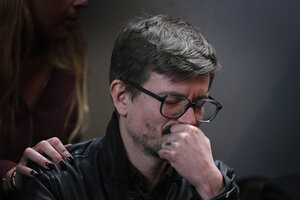Hebdo attacks: Offensive speech is protected. When should it be used?
Charlie Hebdo is publishing a new issue featuring Muhammad on the cover. In the week since a deadly attack on its offices, debate has grown over 'anything is acceptable' attitudes.

Cartoonist Renald Luzier, known as Luz, attends a press conference in Paris on Tuesday. The surviving staff of Charlie Hebdo is putting out an unprecedented 3 million copies of its upcoming issue.
Christophe Ena/AP
Boston
As Charlie Hebdo prepares its first post-massacre edition to run Wednesday – with an image of the prophet saying “Je suis Charlie” on the cover – the issue of free speech in an open society remains live.
The unity march in Paris on Sunday with 40 world leaders was a dramatic statement of support for the values of free speech and the rejection of violence, as French President François Hollande made clear.
Yet the Charlie Hebdo tragedy has also evoked new questions about when speech or satire crosses the line from funny or enlightening into provocative, if not hateful, expression – where ugly or racist depictions are promoted under the safeguards of free speech.
For nearly a decade, Charlie Hebdo has published a wide variety of irreverent cartoons, including of the pope. But it has frequently focused in recent years on the prophet Muhammad, in various depictions bound to irk Muslims. One of the tamer ones has the prophet musing, “Why am I worshiped by such idiots?”
Peter Hervik, a Danish ethnographer who has cataloged the case of the original Muhammad cartoons published in Denmark in 2005, says that an aggressive “anything is acceptable” attitude has often “shut down dialogue, incite hatred, and polarize” in his country.
Mr. Hervik notes that the Swedish media have operated under a different model, refusing to publish denigrating images of Muslims and religious minorities – “not with the idea of censoring, but as a duty to protect the health of democracy, which is another value," he says. "It doesn’t mean Sweden doesn’t have a free press.”
In the English language media, a considerable airing of views in editorials, social media, and essays by rabbis, politicians, cartoonists, and others is questioning absolute free speech if it involves injuring others.
Rabbi Michael Lerner argues in his Berkeley, Calif.-based magazine Tikkun that absolute liberty is a core value in the West, but that “our highest value is treating human beings with love, kindness, generosity.”
A similar sentiment came from cartoonist Jacob Canfield, who told The New York Times that “in the face of a really horrible attack on free speech, it’s important that we don’t blindly disseminate super-racist material."
In the wake of the Hebdo killings, some are arguing for limits or responsibilities beyond “chest-thumping” free speech machismo. In a satirical cartoon published Jan. 9 by the Guardian, longtime war cartoonist Joe Sacco illustrates the sort of gross caricatures – including a black man falling out of a tree holding a banana, and a stereotyped image of a Jewish money lender – that, decades ago, would have been published in the European and American press but today would be seen as completely unacceptable.
“Prohibitions against mocking or denigrating sensitive religious or ethnic symbols are already enshrined in French law,” says Jonathan Laurence, an authority on European Muslims at Boston College, in a phone call. “It is a crime to deny or denigrate the Jewish or Armenian holocaust."
"But you can’t force people or a public to be sensitive or nuanced," he says. "But we can hope for this when the anger dies down.”

